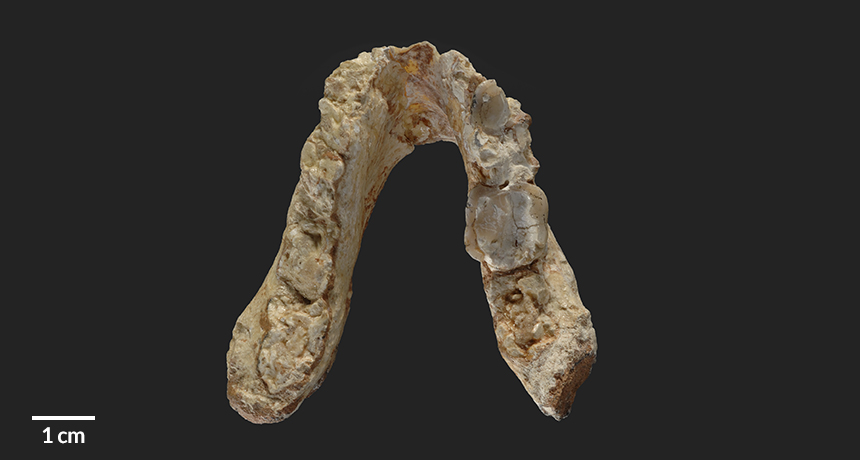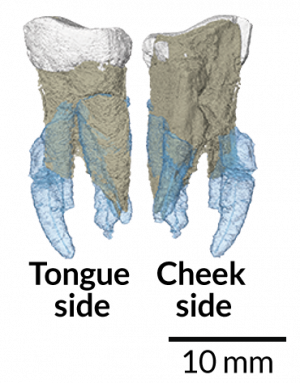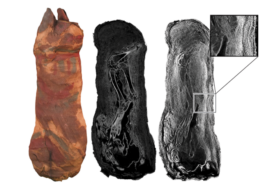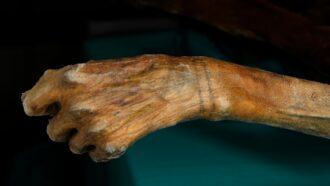European fossils may belong to earliest known hominid
Teeth from this Graecopithecus suggest it may have been part of the human family tree

This jaw and teeth come from a primate that lived more than 7 million years ago. A controversial new claim argues that it might have been the oldest known non-ape human ancestor.
W. Gerber/Univ. of Tübingen
By Bruce Bower
The first members of the human family tree might come from Europe, not Africa.
That controversial conclusion comes from new analyses of a fossil jaw and teeth. They were unearthed at two sites in southeastern Europe. They came from a chimpanzee-sized primate. It is being called Graecopithecus (Gray-ko-PITH-eh-kus), to honor Greece, one source of the fossils. Researchers had assumed it was an ape. But new analyses of features on its teeth suggest that it may instead have been a hominid. Hominids include present-day people and our upright-walking ancestor species.
Graecopithecus appears to have been a new kind of apelike species — one that split from the ancestors of chimps and gorillas. If it was a hominid, this might suggest the first hominids arose in Europe, not in Africa as researchers have long believed. Scientists present data to support their claim in a pair of papers that appeared May 22 in PLOS ONE.
Making this even more believable was the announcement, some two weeks later, by scientists. They reported finding the oldest human fossils in Morocco. This North African site is just a short distance across the Mediterranean Sea from southern Spain (in Europe).
Its ancient roots …
One of the new Graecopithecus analyses focused on clues from a single tooth. This second lower premolar had two partially fused roots. This trait shows up in early hominids. It does not exist in ancient apes, notes Jochen Fuss. A geoscientist, Fuss works at the University of Tübingen in Germany. He led a team that now uses this tooth’s root structure to argue that Graecopithecus was a hominid.

A second team at Tübingen reported new age estimates for the Graecopithecus fossils. One lower jaw dates to just under 7.2 million years ago. It was found in Athens, Greece. Most teeth were still in their sockets. Another single tooth from Bulgaria is a bit older. It’s from around 7.24 million years ago, the scientists say. These ages suggest this species would be the earliest known hominid, says Madelaine Böhme. She’s a geoscientist who led this dating study. Scientists had already suspected that hominids first emerged between 8 million and 6 million years ago.
Jaw and tooth fossils alone aren’t enough to confirm that Graecopithecus was a hominid. For example, it’s not known whether this species regularly walked upright. That is a signature feature of hominids.
Graecopithecus might instead have been an ape with some hominid-like traits. Or, it could have been a hominid with some apelike features. For now, there is no way to tell which, says Bernard Wood. But, he adds, “My guess is the former” — an ape. As a paleoanthropologist, Wood studies ancient human ancestors. He works at George Washington University in Washington, D.C.
David Begun is a paleoanthropologist as well. He works in Canada at the University of Toronto and was part of Fuss’ team. This group examined the fossil teeth with a special scanning device. Known as CT, it uses X-rays to produce a 3-D view of the teeth. It can even show roots hidden in the jaw. Those images showed Graecopithecus teeth had many things in common with those of early hominids.
One that stands out is partial fusion of the second premolar root. Some studies suggest that genes tightly control the number of roots in this tooth. So this root fusion in Graecopithecus would seem to link it to later fossil hominids, explains Begun.
The controversy
Other researchers are skeptical. The number of premolar roots varies even among early hominids, notes Yohannes Haile-Selassie. He is a paleoanthropologist in Ohio at the Cleveland Museum of Natural History. Teeth roots can vary enough to bring into question whether Graecopithecus is a hominid, he says. Haile-Selassie has argued that an East African hominid remains the oldest known.
Most researchers have focused on Africa as the likely origin of hominids. But fossil evidence there is also sparse and under debate, notes Begun. Most discussion centers on fossils from two other potential hominids. Both date to between about 7 million and 6 million years ago. As such, he now argues, Europe is as likely as Africa to be “a place of [hominid] origins, and even of the last common ancestor of chimpanzees and humans.”
Many of the same mammals lived in both Africa and southeastern Europe between 9 million and 7 million years ago. Among them: apes, giraffes, antelopes and hippos. They likely moved back and forth between the continents, Begun says. This makes it hard to pin down where each line of animals arose. Similarly, Graecopithecus could have evolved in either Europe or Africa, he says.
Establishing whether primates such as Graecopithecus are truly hominids is very difficult, says Matthew Skinner. He is a biological anthropologist. He works at the University of Kent in Canterbury, England. Adding to the confusion, few fossils from chimp and gorilla ancestors are available for comparison. But Skinner agrees that researchers should look for hominid origins in Europe as well as in Africa.







